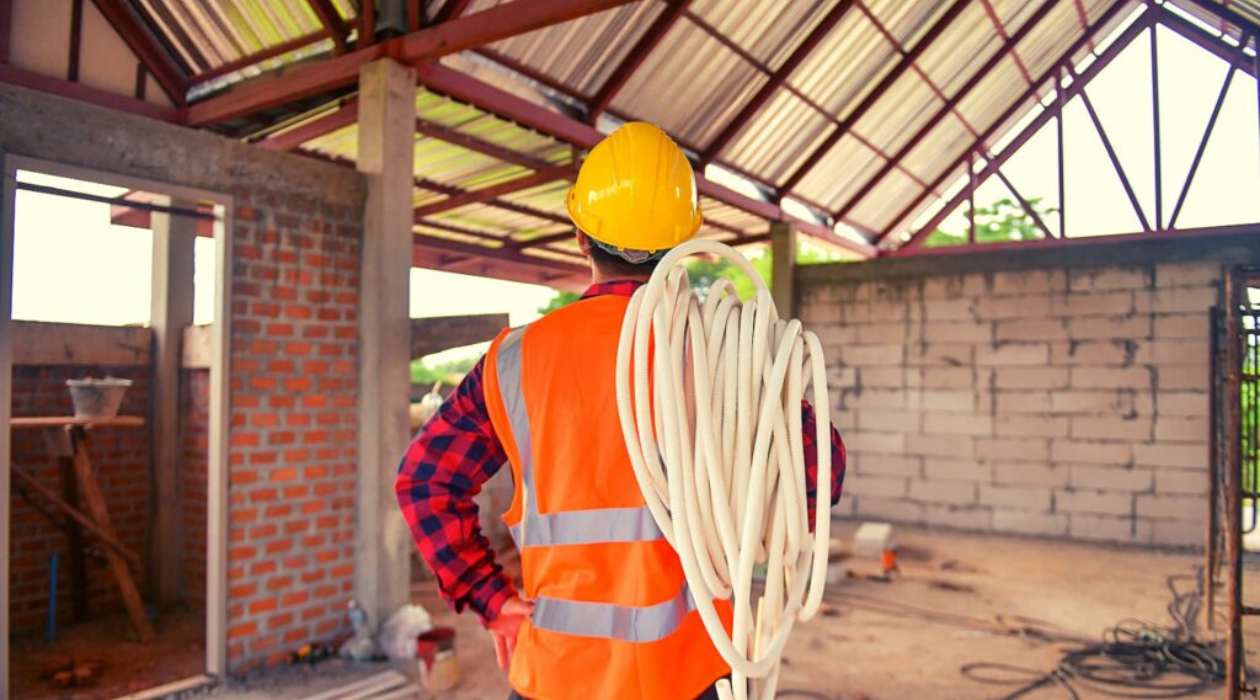Home>diy>Building & Construction>How To Estimate Labor Cost For Construction


Building & Construction
How To Estimate Labor Cost For Construction
Modified: January 9, 2024
Learn how to accurately estimate labor costs for building construction projects with our comprehensive guide. Ensure your project stays within budget and maximize profitability.
(Many of the links in this article redirect to a specific reviewed product. Your purchase of these products through affiliate links helps to generate commission for Storables.com, at no extra cost. Learn more)
Introduction
Welcome to the world of construction! Whether you are a homeowner embarking on a DIY home improvement project or a professional contractor working on a large-scale commercial building, accurate estimating is crucial to the success of your construction project. One of the key components of estimating is labor cost, as it can significantly impact the overall project budget.
In this article, we will dive into the process of estimating labor cost for construction projects. We will explore the factors that affect labor cost, provide tips on estimating labor hours, discuss how to determine labor rates, and offer insight on including overhead and profit. By the end of this article, you will be equipped with valuable knowledge to help you estimate labor cost effectively and efficiently.
Before we delve into the specifics of labor cost estimation, it is important to understand that construction projects are dynamic and unique. Each project comes with its own set of variables, challenges, and requirements, all of which influence the labor cost. It is essential to approach labor cost estimation with a comprehensive understanding of these factors.
So, let’s begin by exploring the various factors that can affect labor cost in construction projects.
Key Takeaways:
- Accurate labor cost estimation is crucial for successful construction projects. Consider project complexity, labor rates, and overhead to create realistic estimates.
- Factors such as project size, location, and skill level impact labor cost estimation. Utilize historical data, consult experts, and stay updated with market rates for accurate estimates.
Read more: How To Estimate Construction Costs
Factors Affecting Labor Cost
When it comes to estimating labor cost for construction projects, several factors come into play. Understanding these factors is essential to accurately estimate the labor cost and minimize the risk of over or underestimating. Let’s take a look at some of the key factors that can affect labor cost:
- Project Complexity: The complexity of the project plays a significant role in determining the labor cost. Projects that require specialized skills, intricate designs, or complex construction methods will generally have higher labor costs.
- Project Size: The size of the project, measured in terms of square footage or volume, can impact labor cost. Generally, larger projects require more labor hours, which in turn increases the labor cost.
- Location: The geographical location of the construction project can affect labor costs. Labor rates can vary from region to region due to differences in labor supply, cost of living, and local market conditions. It’s important to consider the specific location when estimating labor cost.
- Scope of Work: The scope of work refers to the specific tasks and activities involved in the construction project. Projects with a larger scope of work, such as those requiring multiple trades or phases, will have higher labor costs.
- Experience and Skill Level: The experience and skill level required for the project can impact labor costs. Highly skilled and experienced workers typically command higher wages, which can increase the labor cost. It is important to assess the skill level needed for each task when estimating labor cost.
- Availability of Labor: The availability of labor in the construction industry can influence labor costs. In areas where there is high demand and limited labor supply, the cost of labor may be higher. Conversely, in areas with an oversupply of labor, labor costs may be lower.
- Project Schedule: The project schedule and timeline can impact labor costs. Projects with tight deadlines and accelerated schedules may require more labor resources, potentially increasing the overall labor cost.
- Site Conditions: The conditions of the construction site can affect labor costs. Sites with difficult access, environmental challenges, or hazardous conditions may require additional labor hours and expertise, leading to higher labor costs.
It is important to analyze and consider these factors when estimating labor costs for construction projects. By taking these variables into account, you can make more accurate estimations and ensure that your labor cost estimates align with the reality of your project.
Estimating Labor Hours
Estimating labor hours is a critical step in determining the labor cost for a construction project. Accurately estimating the amount of time required for each task is essential for creating a realistic project schedule and budget. Here are some key considerations and techniques for estimating labor hours:
- Break Down the Project: Start by breaking down the project into smaller tasks and activities. This will allow you to assess the labor requirements for each specific task and make more accurate estimations. Consider the different steps involved in the project and the time required for each one.
- Past Project Data: Reviewing past project data can provide valuable insights for estimating labor hours. Analyze similar projects you have completed in the past to identify patterns, average labor hours, and any challenges that may arise. This historical data can serve as a reference point for estimating labor hours in your current project.
- Consult with Experts: Seek input from experienced professionals or subcontractors who have expertise in the specific tasks involved in your project. Their knowledge and insights can help you estimate the labor hours more accurately.
- Consider Productivity Rates: Productivity rates refer to the amount of work that can be completed in a specific timeframe. Take into account the productivity rates of your workers and adjust your labor hour estimates accordingly. Factors such as skill level, experience, and the complexity of the task can impact productivity rates.
- Use Labor Manuals: Labor manuals or databases can be a valuable resource for estimating labor hours. These manuals provide standardized data on labor hours for various construction tasks. They take into account factors such as task difficulty, productivity rates, and skill levels, helping you estimate labor hours with more accuracy.
- Measure and Document: Whenever possible, measure and document the time it takes to complete specific tasks during the construction process. This information can be used as a reference for future projects and help refine your labor hour estimates.
- Apply Adjustments: It’s important to apply adjustments to your labor hour estimates based on specific project conditions. Factors such as site conditions, weather, equipment availability, or accessibility constraints may require additional labor hours, which should be factored into the estimation.
- Review and Update: Estimating labor hours is not a one-time process. Continuously review, update, and refine your labor hour estimates as the project progresses or when new information becomes available. This will help ensure that your labor cost estimation remains accurate and aligned with the reality of the project.
By following these guidelines and utilizing available resources, you can estimate labor hours more effectively and create a realistic labor cost estimation for your construction project.
Determining Labor Rates
Determining labor rates is an important step in estimating labor cost for construction projects. Labor rates vary based on factors such as region, trade, skill level, and experience. Here are some key considerations to help you determine labor rates:
- Market Research: Conduct market research to understand the prevailing labor rates in your specific region. This can be done by contacting local contractors, consulting industry publications, or utilizing online resources. Understanding the market rates will give you a baseline for determining labor rates for your project.
- Trade Classification: Labor rates can vary depending on the trade or skill level required for a specific task. Different trades have their own rate structures based on supply and demand. Research the rates specific to the trades involved in your project to ensure accurate labor cost estimation.
- Union vs. Non-Union: In some areas, labor rates may differ for unionized and non-unionized workers. It is essential to determine whether your project falls under a union contract and factor in any associated rates and benefits when estimating labor cost.
- Experience and Skill Level: Labor rates often increase with the experience and skill level of the worker. Highly skilled and experienced workers, who can bring specialized expertise to the project, may command higher rates. Consider the skill level required for each task and adjust the labor rates accordingly.
- Benefit Packages: Labor rates should include the cost of benefits such as health insurance, retirement plans, and vacation pay. These benefits are part of the total labor cost and should be factored in when determining labor rates.
- Subcontractor Rates: If you plan to subcontract certain tasks, you will need to determine the labor rates for subcontractors. Obtain quotes from subcontractors and factor in their rates when estimating the overall labor cost for your project.
- Inflation and Cost of Living: Keep in mind that labor rates can be influenced by inflation and the cost of living in a specific area. Consider the current economic conditions and any expected changes that may impact labor rates during the course of your project.
- Project Complexity: Some projects require specialized skills or unique challenges that may warrant higher labor rates. Evaluate the complexity of your project and adjust the labor rates accordingly to account for any additional expertise required.
By considering these factors and conducting thorough research, you can determine appropriate labor rates that reflect the specific requirements and conditions of your construction project. It is important to keep in mind that labor rates may vary, and it’s crucial to stay updated with the current market trends.
When estimating labor costs for construction, consider factors such as the type of work, skill level required, local labor rates, and project duration. Use historical data and industry benchmarks for more accurate estimates.
Including Overhead and Profit
When estimating labor cost for construction projects, it’s important to consider overhead and profit in addition to the direct labor rates. Overhead costs are the expenses incurred to support the project, such as office rent, administrative staff wages, equipment, and utilities. Profit is the amount that a contractor adds to the labor cost to cover business expenses and generate income.
Here are some key factors to consider when including overhead and profit in your labor cost estimation:
- Calculate Overhead Expenses: Start by identifying and calculating the overhead expenses associated with the project. This includes costs such as office space, insurance, employee benefits, equipment maintenance, and other general expenses. Estimate these costs and allocate a portion of them to each labor hour or project cost.
- Determine Profit Margin: Determine the desired profit margin for the project. This is the amount of profit you aim to make as a contractor. The profit margin may vary depending on the size and complexity of the project, industry standards, and competitive factors. Consider your business goals and market conditions when setting the profit margin.
- Factor in Project Duration: The duration of the project can influence the amount of overhead and profit included in the labor cost. Longer projects may have higher overhead costs due to extended office and administrative expenses. Adjust the overhead and profit accordingly based on the estimated project duration.
- Allocate Overhead and Profit: Once you have calculated the estimated overhead expenses and determined the desired profit margin, allocate a percentage or specific amount to each labor hour or project cost. This ensures that all direct labor rates are supplemented with the appropriate overhead and profit amounts.
- Review and Update: It’s important to periodically review and update the overhead and profit allocations as the project progresses. As actual expenses and unforeseen circumstances arise, you may need to adjust the overhead and profit to maintain the financial viability of the project.
By considering overhead expenses and profit margins, you can accurately estimate the labor cost for your construction project. This will help ensure that your labor rates cover not only the direct labor costs but also the necessary overhead and profit to sustain and grow your business.
Read more: How To Calculate Construction Labor Cost
Tips for Accurate Labor Cost Estimation
Accurate labor cost estimation is crucial for the success of a construction project. Here are some essential tips to help you achieve accurate labor cost estimation:
- Thoroughly Review Project Plans: Before estimating labor costs, carefully review the project plans and specifications. Understand the scope of work, materials required, and any unique project requirements. This will help you identify the tasks involved and estimate labor hours more accurately.
- Consult with Experts: Seek input from experienced professionals, subcontractors, or colleagues who have expertise in the specific trade or tasks involved in your project. Their insights can help you identify potential challenges, assess labor requirements, and estimate labor costs more accurately.
- Utilize Estimating Software: Consider using construction estimating software to streamline the process and improve accuracy. Estimating software can provide databases of labor rates, factor in industry-specific variables, and help automate the calculation of labor costs based on inputs and project details.
- Keep Historical Data: Maintain a database of past projects to help inform your labor cost estimation. Analyze previous projects’ labor hours, costs, and outcomes to identify trends and average rates. This data can serve as a valuable reference point when estimating labor costs for similar tasks or projects.
- Consider Contingency: Account for unforeseen circumstances and potential changes during the construction process by incorporating a contingency into your labor cost estimation. A contingency allowance can help cover unexpected labor-related expenses and mitigate the risk of underestimating labor costs.
- Stay Updated with Market Rates: Labor rates can fluctuate due to market conditions, trends, or economic factors. Stay informed about the current labor rates in your region and trade to ensure your estimates reflect the most accurate and up-to-date data. Regularly review and update your labor rate database or consult industry resources to stay current.
- Document Assumptions and Exclusions: Clearly document any assumptions or exclusions you have made in your labor cost estimation. This helps ensure transparency and clarity when presenting your estimate to clients or stakeholders. It also helps manage expectations and avoids any misunderstandings regarding what is included or not included in the labor cost estimate.
- Regularly Measure and Track Progress: Throughout the construction process, measure and track the actual labor hours spent on each task. Compare the actual labor hours to the estimated labor hours and adjust your estimation approach as necessary. This will help refine your future labor cost estimates and improve accuracy over time.
By implementing these tips, you can enhance the accuracy of your labor cost estimation. Accurate estimates will not only help you stay within budget but also build trust with clients, make informed decisions, and contribute to the overall success of your construction projects.
Conclusion
Estimating labor cost accurately is a critical aspect of successful construction project management. By considering the factors that affect labor cost, estimating labor hours, determining appropriate labor rates, and including overhead and profit, you can create realistic and comprehensive labor cost estimates. By implementing the tips provided, you can further improve the accuracy of your labor cost estimation process.
Remember that each construction project is unique, so it is important to adapt your estimation approach to the specific requirements and conditions of each project. Continuously review and update your labor cost estimates throughout the project lifecycle, considering any changes or unforeseen circumstances that may impact labor cost.
Accurate labor cost estimation allows you to allocate resources effectively, plan project timelines, and provide clients with reliable cost projections. It helps you avoid unnecessary costs, minimize the risk of over or underestimating, and ultimately contribute to the overall success of your construction projects.
By combining your deep knowledge of building construction with these labor cost estimation techniques, you can confidently navigate the complex landscape of construction projects and deliver exceptional results. Remember to stay informed about industry trends, labor rates, and market conditions to ensure your labor cost estimates remain accurate and reflective of the current landscape.
As you continue to refine and improve your labor cost estimation skills, you will be well-positioned to tackle construction projects with confidence, efficiency, and profitability.
Frequently Asked Questions about How To Estimate Labor Cost For Construction
Was this page helpful?
At Storables.com, we guarantee accurate and reliable information. Our content, validated by Expert Board Contributors, is crafted following stringent Editorial Policies. We're committed to providing you with well-researched, expert-backed insights for all your informational needs.















0 thoughts on “How To Estimate Labor Cost For Construction”